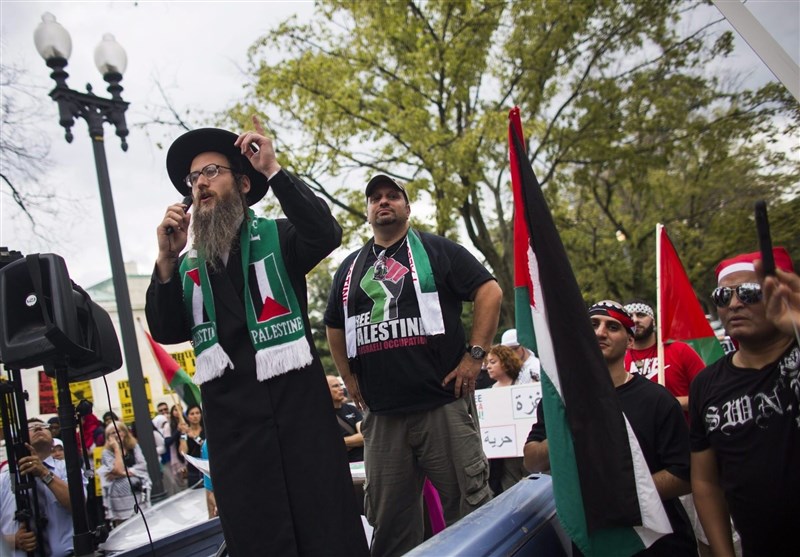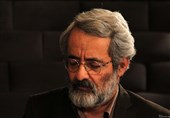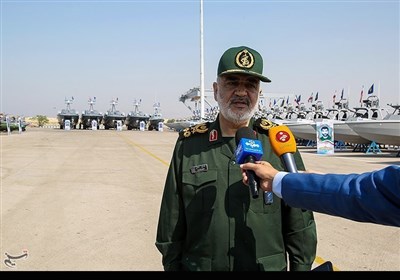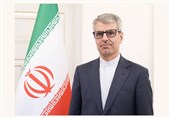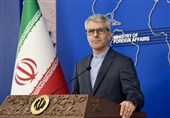An Argument against Ronen Bergman’s 'The Secret War with Iran' – 28
TEHRAN (Tasnim) – Jews have always been among the serious opponents of Zionists. It has to be noted that in all human communities from the past centuries to now, rarely has anyone had an issue with Judaism as a divine religion, despite all distortions.
Iranian journalist and expert Abbas Salimi Namin has disproved the claims and opinions of Israeli analyst Ronen Bergman in the book ‘The Secret War with Iran’. ‘The Secret War with Iran’, written by renowned Zionist journalist Ronen Bergman, was published in 2008 by Simon & Schuster publishing company in the United States.
Born in 1972, Bergman is a graduate of Tel Aviv University in the Middle East political relations. He is a famous Zionist journalist and analyst in the military and security fields who has worked with Israeli newspapers ‘Haaretz’ and ‘Yedioth Ahronoth’, American dailies and weeklies such as ‘The New York Times’, ‘Newsweek’, ‘The Wall street Journal’, and British media groups including ‘The Guardian’ and ‘The Times’.
Bergman has been interested in topics relating to the enemies of the Zionist regime (particularly Iran, Hezbollah and the Palestinian resistance groups), as well as subjects on the history of the Israeli regime’s assassination operations, which are cited in his recent book ‘Rise and Kill First’.
In an interview with Persian TV channel ‘Iran International’, Bergman has pointed to the Iranian nuclear program and the issues surrounding it -particularly the Zionist regime’s secret attempts to halt the process of nuclear activities in Iran and assassinate Iranian scientists. He has also cited ex-CIA chief Michael Hayden as saying that the assassination of nuclear scientists is the best way to impede Iran’s growing process in that field, and has implicitly held Israel responsible for it.
In the book ‘The Secret War with Iran’, Bergman has written a history of encounters between Iran and the Zionist regime, while the bulk of the book relates to the Lebanese Hezbollah -Iran’s main ally in the battle against the Zionist regime since its formation until the 33-day War- focusing on the role of Martyr Imad Mughniyeh.
His book also includes sections about the final years of the Pahlavi regime and victory of the Islamic Revolution in Iran, short periods of the war imposed by the Ba’thist party of Iraq on Iran (focusing on the McFarlane affair), Iran’s role in supporting the Palestinian groups, and the Iranian nuclear program.
Bergman’s multiple undocumented and untrue comments as well as personal and purposeful analyses (with the main purpose of displaying Israel’s power, especially in a competition with the US) that have repeatedly come in his book make a critical review of the book necessary for Iranian readers.
Director of the Iran History Studies and Compilation Bureau, Abbas Salimi Namin, has written an extensive criticism in a book about ‘The Secret War with Iran’. Born in 1954, Salimi Namin is an experienced journalist and a renowned Iranian researcher in history and political sciences who has published many articles and books.
About ‘The Secret War with Iran’
Part 28:
The point to reflect on is that in 1948 when the Zionists occupied Palestine, Yarmook, Hermoon and Litani did not belong to the occupied territories. In the first war the occupiers launched against neighboring states, they were not attached to occupied territories either. However, over these years, Zionist media have incessantly claimed that the national territory (!!) of Jews needs Litani’s water and land located in the southern banks of the river. Therefore, the occupation of Lebanon was not periodical and was rather rooted in the Zionists’ calculations and planning before the occupation of Palestine. That 18 years of popular resistance was endured so that the Lebanese would accept to undergo permanent dominance is a significant issue. The Zionists had created all favorable conditions to stabilize their own dominance. They had convinced their own supporters to accompany them in their excessive demand, hired mercenaries to commit crimes in the name of the Lebanese. Under such circumstances, Palestinians and Lebanese had no option but to make conditions unsafe for the Zionists because international bodies were turning a blind eye to crimes and giving deaf ear to the cries of a nation seeking its most basic rights.
No free-spirited person may frown upon such efforts under such difficult conditions. Kidnapping the intelligence agents of nations involved in the occupation of Lebanon was the minimum reaction to the occupation. However, Mr. Bergman who expectedly seeks to sully the image of the resistance movement fabricates some narratives to give a dramatic aspect to the issue. For instance, referring to a French national who had come to Lebanon during occupation, he writes: “For the first month, Auque was held in a cellar in West Beirut. “That was the most horrible time. I had only a candle and a mattress. When the guards were in the room, my eyes were blindfolded. There was no day and no night. Tiny amounts of food, and terrible solitude. I fluctuated between hope and despair. From time to time one of the guards would come in, cock his weapon, and fire at the wall next to me. A kind of a game. Sometimes they would all come in and say they had decided to execute me.”” (Chapter 7, p. 120)
The hostages are said to have hailed from the Druze and they worked as free contractors for Hezbollah. Such allegations are raised to restrict the extent of resistance. Second, in a bid to accuse Lebanese people of resorting to violence, an unbelievable claim is raised. Normally, hostages should have been held incommunicado, particularly in Beirut where the Zionists and their supporters had many agents and rapporteurs. Now how could hostage-takers proceed with casual shooting in their hideouts – in stark contrast with the most fundamental principles of hiding?! Quoting this French national whose real identity was never known, the author put a more interesting argument: “As Auque explains, Iran was behind it all. “From the moment the abductions began, it was clear that it was not only a matter of pragmatic steps by Hezbollah to get its members freed in other countries. First of all, everybody understood that there were Iranian hands at work here. The commanders of my jailers told me themselves that the orders to kidnap me came from Iran. The goals were much broader and they were part of the protests against and the hatred for the West.” Auque was seized on January 13, 1987, as part of an unprecedented wave of abductions by Hezbollah. “With hindsight, there were clear prior indications,” he recalls. “Friends of mine in Walid Junblatt’s Druze militia warned me I was in danger.”
How can one accuse Iran more evidently?! How can one verify allegations from a bodyguard of hostages? The story is related as if Lebanon were never occupied and that Lebanese people and groups had no motivation to drive occupiers out. As Mr. Bergman states, the Zionists’ treatment of Lebanese people after occupation was such that even groups who were optimistic about Israel joined the Resistance movement. Although the author does not go through details and briefly reviews crimes committed by occupiers and their local agents, it would be easy to feel the depth of a catastrophe endured by Lebanese people and Palestinian refugees for 18 years by referring to other sources. Therefore, the occupation of Lebanon would never end were it not for firm resistance against the Zionists. But Iran is named here in a bid to cover up facts. Berman has pointed out some of such cases: “Among the other petitioners who have won large amounts is Stephen M. Flatow of New Jersey, who in 1998 won a $247.5 million judgment against Iran for sponsoring a 1995 bombing in Israel that killed his daughter, Alisa.” (Chapter 7, p. 136)
In 1998, a Jewish girl was killed in a landmine or bomb explosion in the occupied Palestinian territories. A local court in the US indicted Iran, arguing that Iran was supporting the Palestinian people’s struggle for returning to their homeland. Iran is blamed for the bombing without even naming any perpetrators. That is the strong logic of the Western supporters of Zionism!! Nobody is entitled to defend the right of an oppressed nation – a nation that suffered genocide once in Palestine and then in Jordan and Lebanon just because after the World War, it was decided that a base be built over the ruins of Palestinian homes. To that end, the Western propaganda apparatus first fabricated the Holocaust in a bid to cover up the real crimes committed in Palestine. Then, the Zionists were given a free hand for any action. It may be imagined that the crimes committed by this racist community were limited to Muslims. Not at all! Any voice against establishment of this base was stifled. In Rise and Kill First, Bergman has had to highlight some cases of assassination of Jews by the Zionists.
“The members of Hashomer who led the Haganah at the outset were even willing to commit acts of violence against fellow Jews. Jacob de Haan was a Dutch-born Haredi—an ultra-Orthodox Jew—living in Jerusalem in the early 1920s. He was a propagandist for the Haredi belief that only the Messiah could establish a Jewish state, that God alone would decide when to return the Jews to their ancestral homeland, and that humans trying to expedite the process were committing a grave sin. In other words, de Haan was a staunch anti-Zionist, and he was surprisingly adept at swaying international opinion. To Yitzhak Ben-Zvi, by now a prominent Haganah leader, that made de Haan dangerous. So he ordered his death. On June 30, 1924—just a day before de Haan was to travel to London to ask the British government to reconsider its promise to establish a Jewish nation in Palestine—two assassins shot him three times as he emerged from a synagogue on Jaffa Road in Jerusalem.” (Rise and Kill First, Ronen Bergman, p. 23)
Jews have always been among the serious opponents of Zionists. It has to be noted that in all human communities from the past centuries to now, rarely has anyone had an issue with Judaism as a divine religion (despite all distortions) and history shows that most conflicts are to blame on the unprincipled behavior of Jewish ethnicity. The characteristics of Jewish ethnicity had throughout history given rise to a serious conflict between them and followers of other religions, which in some cases Judaism has not been spared. Jewish ethnicity does not believe in divinity, nor does it insist on Judaism; rather, it insists on ethnicity and seeks political, economic and military dominance on other nations. Therefore, we are faced with Jewish ethnicity that has set the stage for the emergence of Zionism. It has not hesitated to sacrifice those believing in Judaism only for its own interests. Although the author has sought to restrict this conflict to individual cases, the fact is that followers of Judaism have been among the main opponents of Zionism and have paid a heavy price. A confidential report from the Imperial Iran’s embassy in Baghdad in July 1946, under title “Society to Combat Zionism in Iraq” sheds light on this confrontation from the very beginning of Zionist machinations in Palestine. “The Foreign Ministry – Several months ago, a group of young Muslims and Jews in Iraq formed the Society to Combat Zionism and printed a newspaper. The slogan adopted by this society, as its name suggests, is to fight Zionism. But gradually it has become more active particularly after the British-American Joint Committee released its report about the migration of Jews to Palestine. It fired broadsides at colonialist governments…A group affiliated with this society held an illegal gathering and marched through streets of Baghdad…They crossed a bridge to reach the British embassy. The guards blocked them and reinforcements also arrived. But due to the resistance of demonstrators, police fired shots at them and scuffles broke out. Several were injured. One of them, Shaul Taviq (a Jew) has died and the rest – four Muslims – are hospitalized. Signed by State Minister, Mosen Raeis” (Documents on Migration of Iranian Jews to Palestine, pp. 92-93, Iran National Documents Organization)
